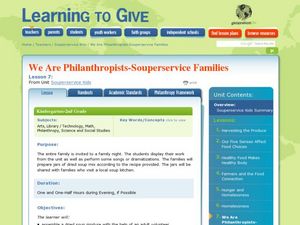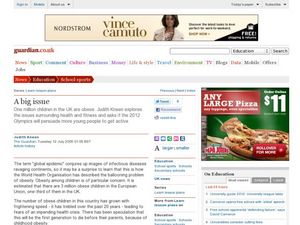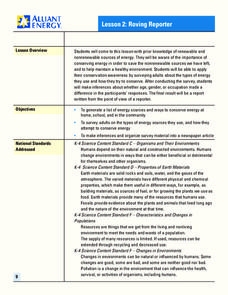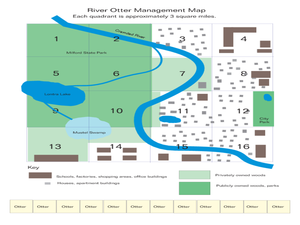Curated OER
Bubble and Squeak
Students complete a unit on the chemical and technological processes of food preparation. They observe various experiments, describe changes in materials through cooking, identify safety and hygiene issues, and cook various recipes.
Curated OER
Why are Vitamins and Minerals Important?
Fifth graders examine role vitamins and minerals play in maintaining healthy body and strong heart, differentiate between vitamins and minerals, gain
understanding of function of each type of vitamin and mineral, and practice choosing...
Curated OER
Nutrition: Gregory the Terrible Eater
Young scholars listen to a story about a goat who craves human food. They discover the four basic food groups and discuss what they might eat if they were terrible eaters. Students retell the story by looking at the pictures. They...
Curated OER
Read the Label
Students read the Nutrition Fact labels to make healthy choices. For this health lesson, students look at labels to identify fat content, protein, carbohydrates, and serving size. They play games with different labels such as Narrow It...
Curated OER
We Are Philanthropists- Soup service Families
Students complete a service project. In this philanthropy lesson, students gather with their families to discuss how they can give to others. Students and their families prepare jars of dried soup mix that will be distributed to local...
Curated OER
Health Benefits of Rice
Sixth graders examine the health benefits of rice. In this food benefits lesson, 6th graders discover the nutritious benefits of rice. Students research Celiac Sprue disease and how rice benefits the people with this disease.
Curated OER
Living and Non-Living
Students discover the basic needs of life. In this science lesson plan, students explore how all living things need air, water, food and shelter
Curated OER
Mineralization
Learners investigate demineralization and remineralization and find common foods that promote these things. In this investigative lesson students compare effects of this on fluoride and non-fluoride treated substances and establish the...
Curated OER
National Sterotypes
Students develop their own ideas about the world around them. This lesson helps them improve their descriptive adjective vocabulary while they discuss perceived differences between nations through stereotypes.
Curated OER
It's all Interconnected
Students participate in a number of activities to investigate the food web, species extinction, predators and prey, and biological diversity.
Curated OER
Stay Fit, 'Cause You Never Know.
Young scholars identify what "Active Living" means and compare and contrast the relationship between fitness and active living by developing a recipe for Active Living. They examine Canada's Food Guide to Healthy Eating and the...
Curated OER
Hunger and Malnutrition
Sixth graders use a variety of resources to determine the importance of getting the proper nutrients. In this nutrition lesson, student complete an activity in which they examine the world issue of hunger and malnutrition. They locate...
Curated OER
Science
Students read labels of candy bars. In this ingredients lesson, students examine a variety of candy bar labels to determine the contents. Students research to find additional information on each candy bar, then write an opinion article...
Curated OER
Parental Responsibilities
Students discuss their responsibilities and experiences as parents. Individually, students create a list of parental responsibilities. Individual lists are combined and discussed with the whole class. This activity is designed for...
Curated OER
Edible Soil
Students model the soils layers using Oreo's. In this lesson students use their favorite food items to create a model of soil layers. A discovery lesson from a youth camp is adapted for classroom modeling and discussion of soil ecology....
Curated OER
Hunger and Malnutrition
Fifth graders investigate hunger and malnutrition. In this hunger and malnutrition lesson, 5th graders study the importance of proper nutrition. Students explore the scope of hunger and malnutrition problems.
Curated OER
A Big Issue
Young scholars examine the issue of childhood obesity. In this current events lesson plan, students explore the personal health issue as they discuss balanced diets, food diaries, and the 2012 London Olympics. Suggestions for classroom...
Curated OER
Health & Safety
Students are introduced to the standards for health in the child care system. After watching a PowerPoint presentation, they plan healthy snacks for children. To end the lesson, they review the proper safety measures to have in their...
Curated OER
Goal Setting: Respect for ALL Workers
Students discuss their views on the importance of various jobs. For this career paths and goal-setting lesson, students create a list of all jobs required to produce a particular object. Students then prioritize the importance of...
Curated OER
Life Cycle
Seventh graders make a collage of the human life cycle. In this life cycle lesson students study the human reproductive system and the general concepts of pregnancy. Students receive detailed information about the human life cycle and...
Curated OER
Diseases
Sixth graders create a type of notebook or journal using colored copy paper on which to take notes. They complete research on a certain disease and report on it and then design their own disease causing bacteria or virus. Finally, 6th...
Curated OER
Primary Resources
In this teacher website, teachers have access to various worksheets and lesson plans at no cost. Teachers can select from all subject areas for lesson plans, activities, and available resources.
Curated OER
Roving Reporter
Learners write a report about energy use. In this conservation lesson, students interview adults about their use of renewable and nonrenewable energy. Learners synthesize this information and write a report from the point of view of a...
Curated OER
Too Many Otters
Second graders investigate the habitat of otters. In this animal science lesson, 2nd graders role play the job of wildlife biologists and try to manage the otter population. Students use a map to track their specific otter population.

























